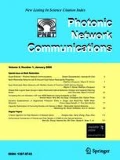Abstract
A wavelength-routed optical network can suffer inefficiencies due to the wavelength-continuity constraint (under which a signal has to remain on the same wavelength from the source to the destination). In order to eliminate or reduce the effects of this constraint, a device called a wavelength converter may be utilized. Due to the high cost of these wavelength converters, many studies have attempted to determine the exact benefits of wavelength conversion. However, most of these studies have focused on optical networks that implement full wavelength conversion capabilities. An alternative to full wavelength conversion is to employ only a sparse number of wavelength converters throughout the network, thereby reducing network costs. This study will focus on different versions of sparse wavelength conversion--namely, sparse nodal conversion, sparse switch-output conversion, and sparse (or limited) range conversion--to determine if most of the benefits of full conversion can be obtained using only sparse conversion. Simulation and analytical results on these three different classes of sparse wavelength conversion will be presented. In addition, this study will present heuristic techniques for the placement of sparse conversion facilities within an optical network.
Similar content being viewed by others
References
K. C. Lee, V. O. K. Li, A wavelength convertible optical network, Journal of Lightwave Technology, vol. 11, no.5/6, (May/June 1993), pp. 962-970.
R. Ramaswami, K. Sivarajan, Optimal routing and wavelength assignment in alloptical networks, Proc. of IEEE INFOCOM '94 (Toronto, Ontario, Canada, June 1996), vol. 2, pp. 970-979.
R. Barry, P. Humblet, Models of blocking probability in alloptical networks with and without wavelength changers, Proc. of IEEE INFOCOM '95 (Boston, MA, April 1995), vol. 2, pp. 402-412.
A. Birman, Computing approximate blocking probabilities for a class of alloptical networks, Proc. of IEEE INFOCOM '95 (Boston, MA, April 1995), vol. 2, pp. 651-658.
M. Kovacevic, A. Acampora, On wavelength translation in alloptical networks, Proc. of IEEE INFOCOM '95 (Boston, MA, April 1995), vol. 2, pp. 413-422.
R. Barry, D. Marquis, Evaluation of a model of blocking probability in alloptical mesh networks without wavelength changers, Proc. of SPIE East '95 (Philadelphia, PA, October 1995), pp. 154-167.
S. Subramaniam, M. Azizoglu, A. Somani, Connectivity and sparse wavelength conversion in wavelength routing networks, Proc. of IEEE INFOCOM '96 (San Francisco, CA, March 1996), vol. 1, pp. 148-155.
J. Yates, J. Lacey, D. Everitt, M. Summerfield, Limited range wavelength translation in alloptical networks, Proc. of IEEE INFOCOM '96 (San Fransisco, CA, March 1996), vol. 3, pp. 954-961.
J. Iness, Efficient Use of Optical Components In WDM Networks, Ph.D. Dissertation, Department of Computer Science, University of California, Davis, November 1997.
S. J. B. Yoo, Wavelength conversion technologies for WDM network applications, Journal of Lightwave Technology, vol. 14, no.6, (June 1996), pp. 955-966.
Author information
Authors and Affiliations
Rights and permissions
About this article
Cite this article
Iness, J., Mukherjee, B. Sparse Wavelength Conversion in Wavelength-Routed WDM Optical Networks*. Photonic Network Communications 1, 183–205 (1999). https://doi.org/10.1023/A:1010027128404
Issue Date:
DOI: https://doi.org/10.1023/A:1010027128404




